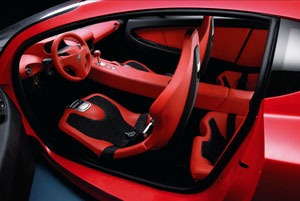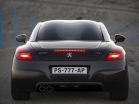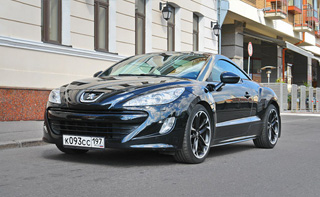PEUGEOT RCZ test drive since 2009 compartment
Trump deuce
 Quazar, Oxia, Proxima, Asphalte, Feline - Do not think that Peugeot has only been engaged in sports concepts today. After all, there were loud victories in Le-Man in the history of the company. The magic of large races and today continues to fascinate engineers and designers in La Garenn-Kolom.
Quazar, Oxia, Proxima, Asphalte, Feline - Do not think that Peugeot has only been engaged in sports concepts today. After all, there were loud victories in Le-Man in the history of the company. The magic of large races and today continues to fascinate engineers and designers in La Garenn-Kolom. In terms of spirit, the Peugeot RC card couple - Carreau and Pique - is very close to experimental machines created in the 80s. In these concept karas shown at the Geneva Motor Show (designer Nicholas Brissonnya), both form as a whole and individual elements are impressive. An equal partner of the PEUGEOT RC design is aerodynamics. For example, in racing practice, diffusers in the bottom of the car are widely used to increase the clamping force (they accelerate the passage of air flow under the body). And now we see this aerodynamic element (with several vertical stabilizing ribs) at the back of these machines, framed by the rear foglight heads.
Scorpio tail is something new. Stories are known for fish and boat tails, but this is from long -obsolete terminology. In this case, we are talking about unusually tilted and seeming to the horses of both cars hung up from this. It is known that the higher the upper edge of the stern is raised, the smaller the lifting force. Moreover, it can also become pressing, which will very positively affect the stability of the car at high speed. But an increase in the clamping force, no matter how the aerodynamics are twisted, entails a directly proportional increase in the circuits. Therefore, a controlled flap is used in RC, which extends by 40 mm. But even if it is removed, the lifting force is zero.
 We open doors such as the wings of the beetle (this term, on the contrary, is widely used). The car interior (2+2) gives the impression of a serial product. It is deprived of the conventionality that are often endowed with the interiors of the concepts, and characteristic bizarre solutions. Here is more and more real: dense two -tone leather upholstery (the same in both machines); liquid crystal monitors at the site of the instrument panel and the control sections of secondary functions (speedometer - digital, tachometer - analog, both are made in the style of chronographs); The bucket-shaped carbon fiber chairs with four-pointed safety belts ... The Italian company Magneti Marelli delivered a 6-speed manual gearbox with electrohydraulic switching for machines. The driver can manage the transmission both with the help of a traditional lever on the central body tunnel and two buttons on the steering wheel.
We open doors such as the wings of the beetle (this term, on the contrary, is widely used). The car interior (2+2) gives the impression of a serial product. It is deprived of the conventionality that are often endowed with the interiors of the concepts, and characteristic bizarre solutions. Here is more and more real: dense two -tone leather upholstery (the same in both machines); liquid crystal monitors at the site of the instrument panel and the control sections of secondary functions (speedometer - digital, tachometer - analog, both are made in the style of chronographs); The bucket-shaped carbon fiber chairs with four-pointed safety belts ... The Italian company Magneti Marelli delivered a 6-speed manual gearbox with electrohydraulic switching for machines. The driver can manage the transmission both with the help of a traditional lever on the central body tunnel and two buttons on the steering wheel. The body of the cards are identical (dimensions - 4300x1800x1150 mm, base - 2800 mm), only the color is different. They are bearing, formed and seduced in autoclave from cellular carbon fiber sandwich panels - only the front wings, hoods and doors are hung. The body structure includes a safety frame and a roof of high -strength steel. In front of the body, an aluminum double-leaf suspension and the steering mechanism are attached, a spatial tubular subframe on which the power unit, transmission and suspension on double-transverse aluminum levers, and a spring-amortization stand based on the upper lever are fixed. In a word, we have a seriously worked out chassis in front of us!
 The peak Peugeot RC has a row four-cylinder gasoline engine with a working volume of 1997 cm cubic meter, developing a capacity of 133 kW and mac-symbolic torque of 202 Nm, while the hubby diesel was received by HDI (2168 cm cubic meter, 400 nm). In addition to direct injection, the two upper distribution shafts and turbocharges with variable geometry, this engine has a filter-solid particle filter in the production system of exhaust gases.
The peak Peugeot RC has a row four-cylinder gasoline engine with a working volume of 1997 cm cubic meter, developing a capacity of 133 kW and mac-symbolic torque of 202 Nm, while the hubby diesel was received by HDI (2168 cm cubic meter, 400 nm). In addition to direct injection, the two upper distribution shafts and turbocharges with variable geometry, this engine has a filter-solid particle filter in the production system of exhaust gases. The cooling system in both cards is similar and includes two radiators spaced on the left and right sides of the front line. Since the air removal channels are located in the low -pressure zone, the working surface of the radiators was reduced. An additional heat exchanger is also established in the diesel version. The channels of the air vent are one of the most piquant details of the design of machines. You do not immediately understand that the sidewall of the body is dissected, and the front wing seems to run into the body. However, both Proxima (1987) and Oxia (1988), also created under the leadership of Gerard Velter, the current chef-designer of the company, could boast of such plastic.
 18 -inch wheels are impressive - cast, made of magnesium alloy, with two rows of flat knitting needles. And again, everything is very realistic - they are not shod in any avant -garde PAX tires, but in the most widespread Michelin Pilot Sport size 245/45R18.
18 -inch wheels are impressive - cast, made of magnesium alloy, with two rows of flat knitting needles. And again, everything is very realistic - they are not shod in any avant -garde PAX tires, but in the most widespread Michelin Pilot Sport size 245/45R18. In general, both cars leave the impression of not abstract concepts, but deeply worked out road versions. So the technical characteristics arrived: the equipped mass - 900-950 kg, acceleration 0-100 km/h - 6 sec., Speed \u200b\u200b- 230 km/h, fuel consumption - 7.7 l/100 km (gasoline) and 4.9 l/100 km (diesel). It is not a sin with such trump cards and playing the supercars market.
Text: Denis Orlov
Source: Motor magazine [No. 4/2002]









